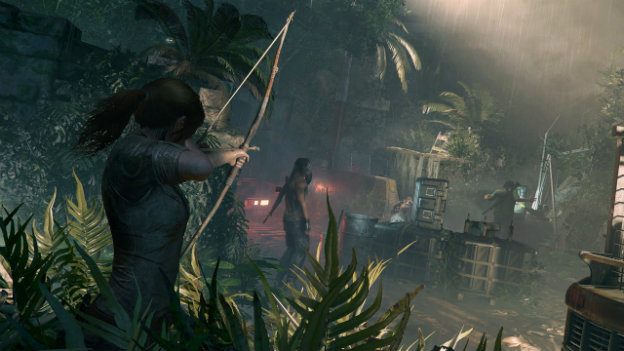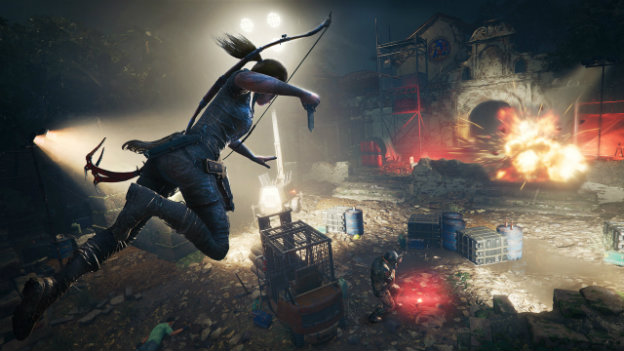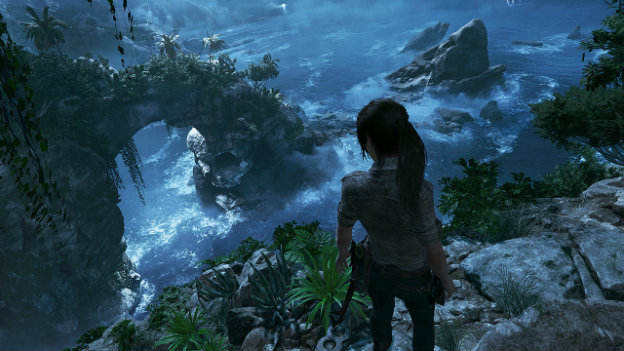The Gang Starts the Apocalypse
The Tomb Raider remake trilogy has had a fascinating trajectory. In 2013, Crystal Dynamics and Square Enix dropped a direct challenge to Uncharted , a reboot of a dormant franchise that used to be a huge deal. It re-emerged as a stealth/action game that felt like playing Uncharted , but had a much grittier edge to it. It was super successful in a cultural sense, revitalizing the Tomb Raider brand big time and giving new life to a stale, cheesecake character as one of modern gaming’s top heroines. But Square Enix was going through some stuff at the time, and headlines were dominated by reports of the game “underperforming” internally, despite millions in sales.
Still, a sequel was made, but it ended up suffering as a timed Xbox One exclusive at a time when that didn’t do any games any favors. Now, with Shadow of the Tomb Raider , the majority of development has moved from Crystal Dynamics to Eidos Montreal, the dev house behind the resting Deus Ex series. It’s been a bumpy road for what started out as a hot remake property, and I approached this new game cautiously, but with some optimism. This is the end of the trilogy, and the series could go anywhere from here. Do we need another fresh start, or do we have a solid foundation to keep adding to?
Before really diving into Shadow of the Tomb Raider , it’s important to talk about Rise of the Tomb Raider for a bit. The second Tomb Raider of this trilogy was troubled, and it’s not just because of its market context. Obviously, the first game was a hit and the sequel needed to come, and AAA sequels generally aim for bigger and better. The first Tomb Raider was almost comparable to a Metroidvania-style experience, but Rise of the Tomb Raider went more towards an open world of sorts, albeit with multiple locations.
But in doing that, the game felt bloated, with tons of padding in the way of collectibles and hidden tombs, many of which were super elaborate. These were cool, but divorced from the story (a frustrating choice that continues in Shadow of the Tomb Raider ), which quickly got bogged down in drama with Trinity, a mysterious organization that continues to haunt the Croft family. Lara’s journey to fight Trinity and avenge her father took center stage, while the first game succeeded by focusing on building character. Rise of the Tomb Raider was ambitious, but deeply flawed in these areas, and Shadow of the Tomb Raider aims to course correct, all while still wrapping up that story.
First and foremost, the critical path of Shadow of the Tomb Raider is much breezier than its predecessor. It’s faster, more focused, and attempts to be more about Lara, as opposed to constant yelling about Trinity. (Although, Trinity is still the primary antagonistic force.) It also attempts some commentary on the nature of Uncharted -style action-adventure archaeologists and how much harm they really do to cultures they have no business inserting themselves into. It’s an interesting approach, albeit on the clumsy side. It also takes some time to really flesh out the combat mechanics, while the previous game sort of added some extra stuff to, making the experience of playing Shadow of the Tomb Raider really stand out. Unfortunately, it’s also marred with a sense of jank that hasn’t been present in the series until now.
Shadow of the Tomb Raider ’s story is interesting, as it’s framed by Lara herself making a huge mistake, literally kickstarting the apocalypse. It’s a bit hyperbolic, although this game is all-in with the supernatural stuff and frankly better for it. Setting off a chain of natural disasters, Lara is forced to finally question her motives coming out of the second game, which basically saw her obsessing over Trinity to the detriment of her life and personal relationships. That, and the whole digging through ruins, sticking her nose where it doesn’t belong thing. Sure, Trinity is weird and violent, but is Lara making things better by retaliating? Figuring out the answer is the crux of Shadow of the Tomb Raider ’s overall story. Much of the plot ends up being about chasing the big bad, but it goes to some interesting places and is punctuated by some really wild setpieces. The climax is just ludicrous and makes for a great payoff after everything.

Connecting those setpieces are different types of gameplay sections, which Shadow of the Tomb Raider actually has separate difficulty settings for. It’s a cool move on the part of the developers, one that embraces how individual games can have very diverse audiences and shows giving people different options doesn’t hurt the game at all. These settings range from hiding telltale signs of interactivity to make exploration more rewarding, to making combat sections and puzzles as trivial as possible. Combat especially benefits from this, thanks to some additions to this game that make the whole experience feel much more well-rounded.
Previous Tomb Raider titles suffered from an all or nothing approach to stealth sections, meaning if you were caught, it was up to you to survive the subsequent enemy onslaught. Shadow of the Tomb Raider wants to be more robust and is more like other stealth games in that Lara can make a mistake, but recover and reenter stealth. This is a boon in and of itself, but Lara also has an extra list of options that help her navigate combat sections more gracefully. This includes new options for sneaking in terrain, with sections of wall she’s able to slide up against, mud she can use to hide more effectively, and new takedown options such as some really intensely animated, Batman-like perch takedowns that are a joy to pull off. Combat sections could be a drag in Rise of the Tomb Raider , but in Shadow of the Tomb Raider , they’re much more engaging and feel fresh in the way the “first” game did.

Unfortunately, I found that the familiar, Uncharted -like platforming sections were not nearly as fun to get through, and actually come off as way too Uncharted -like in the worst kind of way. For the most part, getting around the Tomb Raider world plays out like you’d expect. There are distinct markings (unless you notch up the difficulty), and you slide, climb, pull, and swing your way around dangerous terrain that predictably breaks when Lara is in a hurry. The problem is, it’s really, glaringly unstable in a way the first two games almost never were. It’s like going back to the original Uncharted trilogy, in which the games would constantly betray you through no fault of your own.
Either the camera wigs out or you’re running through an intense, scripted challenge. Despite doing the right thing, because it’s all pretty clearly telegraphed, you fall to your death anyway, reload, do the same exact thing, and then either succeed or die again until you do. It’s really frustrating, as it never feels like it’s your fault that you died, so you don’t learn anything. It’s just the physics deciding you were slightly off the mark, just enough to where you don’t even feel the difference in how you interact with the controller when you do make it past the hazards. This is all punctuated by the series’ most glaring issues, the bizarre, fetishistic death scenes that don’t fit the game’s tone at all and that Crystal Dynamics respectfully dialed back on in the previous game. Shadow of the Tomb Raider leans back in on them even more, and it’s very uncomfortable whenever Lara dies. I’m no violence prude, but tone and context matter, and here they conflict big time.

Shadow of the Tomb Raider is a messy ending to a messy remake of a messy franchise. But it’s messy in a way I was compelled to see through to the end, shining in ways that were engaging and faltering in ways that fall far from ruining anything.This Tomb Raider trilogy has been full of ambition and missteps, but never failures, and Shadow of the Tomb Raider , despite its problems, ends things on a high note that reminded me both why I loved the 2013 reintroduction so much and why Rise of the Tomb Raider left me wanting. It lies somewhere in-between, and I’m glad the Trinity story has concluded so we can move on to something new again.
RATING OUT OF 5 RATING DESCRIPTION 5.0 Graphics
If nothing else these games are darn pretty to look at 3.5 Control
A bit too complex and fumbly despite how good the core play feels, platforming sections oddly frustrating 4.0 Music / Sound FX / Voice Acting
Excellent voice acting as per usual with the series, including an “immersive” option that makes the game more multilingual 4.0 Play Value
Lots of extra collectibles, skill tree stuff, and of course all the optional tombs to explore 4.0 Overall Rating – Great
Not an average. See Rating legend below for a final score breakdown.
| Review Rating Legend | |||
|---|---|---|---|
| 0.1 – 1.9 = Avoid | 2.5 – 2.9 = Average | 3.5 – 3.9 = Good | 4.5 – 4.9 = Must Buy |
| 2.0 – 2.4 = Poor | 3.0 – 3.4 = Fair | 4.0 – 4.4 = Great | 5.0 = The Best |
Game Features:
